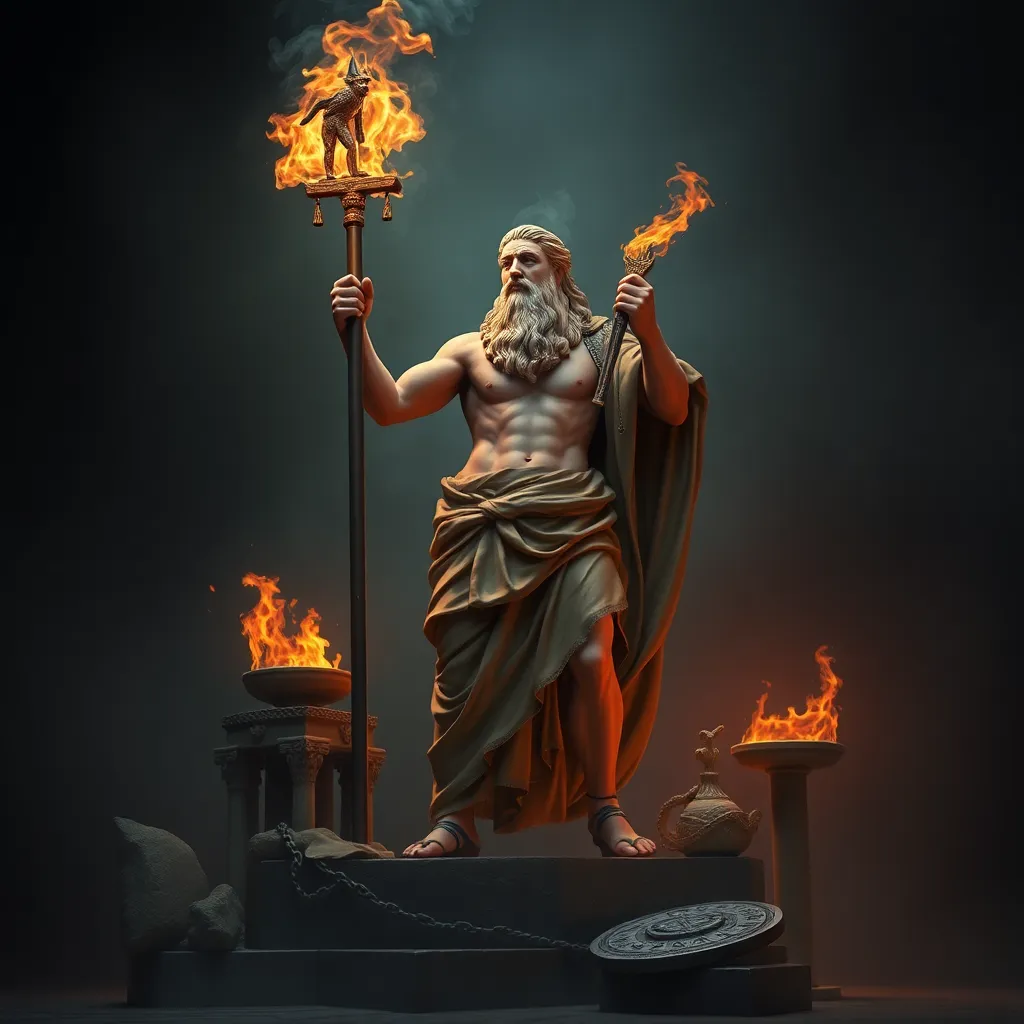The Role of Hephaestus in the Pantheon: God of Fire and Craftsmanship
I. Introduction
Hephaestus, the god of fire and craftsmanship, holds a unique place in Greek mythology. As the divine smith and artisan, he represents the transformative power of fire and the creativity inherent in craftsmanship. In ancient Greek culture, fire was not only a source of warmth and light but also a crucial element in the forging of tools, weapons, and art. This article explores the origins, significance, and enduring legacy of Hephaestus in the pantheon of Greek gods.
II. Origins and Birth of Hephaestus
Hephaestus’ birth is shrouded in various mythological accounts. Most notably, he is said to be the son of Hera and Zeus. Some versions of the myth suggest that Hera gave birth to Hephaestus without Zeus’s involvement, in a bid for revenge against him, which reflects her desire for independence and power.
Hephaestus is often depicted as physically disabled, which is significant in several ways:
- His lameness symbolizes the idea that physical imperfections do not diminish one’s worth or abilities.
- His status as the ‘ugly’ god contrasts sharply with the beauty of other Olympians, highlighting the theme of inner versus outer beauty.
- His disabilities make him relatable to humanity, emphasizing his role as a craftsman who overcomes challenges through skill and creativity.
III. Hephaestus’ Role Among the Olympian Gods
Within the Olympian pantheon, Hephaestus occupies a unique position. Unlike many of the other gods, who are often associated with power, beauty, and warfare, Hephaestus embodies the spirit of labor and creativity.
His relationships with other gods and goddesses illustrate his importance:
- He is married to Aphrodite, the goddess of love and beauty, creating a contrast between their domains.
- He has a contentious relationship with Ares, Aphrodite’s lover, reflecting themes of jealousy and rivalry.
- His friendship with Athena, the goddess of wisdom, highlights a mutual respect for skill and intellect.
In contrast to other Olympians, such as Ares, who represent chaos and aggression, or Athena, who embodies strategic warfare, Hephaestus is associated with the constructive aspects of creation.
IV. Symbolism of Fire and Craftsmanship
Fire is a central element in Hephaestus’ story, symbolizing transformation, destruction, and rebirth. It serves as a metaphor for the dual nature of creativity:
- As a tool for forging new creations, fire represents innovation and progress.
- Conversely, fire can also signify destruction, reflecting the consequences of unchecked passion and aggression.
The significance of craftsmanship in ancient Greek society cannot be overstated. Craftsmanship represented not only survival and practicality but also artistry and innovation. Hephaestus’ role as the god of craftsmanship positions him as a symbol of:
- Creativity: Encouraging human ingenuity and the creative spirit.
- Innovation: Inspiring advancements in technology and art.
- Resilience: Demonstrating that skills can lead to triumph over adversity.
V. Myths and Legends Featuring Hephaestus
Hephaestus is central to several key myths that highlight his character and skills:
- The Creation of Pandora: Hephaestus was tasked with creating Pandora, the first woman, as a gift to mankind. This myth underscores the complexity of creation, as Pandora brings both gifts and misfortune to humanity.
- Crafting Weapons and Armor: Hephaestus is renowned for forging legendary weapons for gods and heroes, including:
- The shield of Achilles, which depicted scenes of both war and peace.
- The thunderbolts of Zeus, representing divine power.
- The armor of Heracles, showcasing his craftsmanship and skill.
VI. Hephaestus in Art and Literature
Hephaestus has been depicted in various forms of art and literature throughout history. In ancient Greek art, he is often portrayed as a bearded man working at an anvil, surrounded by tools of craftsmanship. Notable examples include:
- Statues and reliefs found in temples and public spaces.
- Pottery that illustrates scenes from his myths.
In classical literature, Hephaestus appears in:
- Homer’s Iliad, where he plays a vital role in the crafting of divine armor.
- Works by Hesiod, which detail his birth and character.
Modern interpretations of Hephaestus continue to explore his themes of creativity and resilience, often portraying him as a symbol for those who create in the face of adversity.
VII. Worship and Temples Dedicated to Hephaestus
Hephaestus was worshipped in various parts of ancient Greece, particularly among those who valued craftsmanship and fire-related skills. Key aspects of his worship include:
- Temples: The most notable temple dedicated to Hephaestus is the Temple of Hephaestus in Athens, which stands as a testament to his importance in Greek culture.
- Rituals: Craftsmen and blacksmiths would often offer sacrifices to Hephaestus, seeking his blessings for their work.
- Festivals: Various festivals celebrated the skills of artisans, often invoking Hephaestus for inspiration and creativity.
VIII. Conclusion
Hephaestus’ contributions to Greek mythology and culture are profound. As the god of fire and craftsmanship, he embodies the spirit of creativity and resilience, reminding us that true strength lies not only in power but also in skill and innovation. His legacy endures in modern interpretations of mythology, where he continues to inspire artists, craftsmen, and creators to embrace their talents and overcome obstacles.
Ultimately, the significance of craftsmanship and creativity in society remains as relevant today as it was in ancient Greece, making Hephaestus a timeless symbol of the power of human ingenuity.




